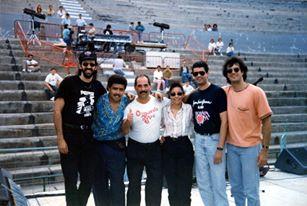m0squis escribió:
Klaus, entre el libro y lo que has ido contando en este hilo, se ve que tienes conocimientos de sobra para componer el próximo superhit del verano patrio. Así que déjate de cháchara y a por ello...
Al hilo de esto, como comenté estoy terminando el libro de John Seabrook, The Song Factory que es básicamente un fresco de la trastienda del Billboard. Y es interesante un capítulo que habla de la forma de componer que se conoce como "track & hook".
El track&hook consiste en que los productores desarrollan bases (tracks) y grooves que remiten a lo que se conoce como top-liners, gente que tiene talento para crear hooks... en un proceso colaborativo de escritura del tema. La cuestión es que un productor puede mandar las mismas bases hasta medio centenar de top-liners a la espera de que alguno le devuelva una melodía que asegure el éxito. El resultado final es como comentasteis hace muchos post atrás: un frankenstein hecho de muchas piezas de distintos autores.
Obviamente aquí no suele haber ni letra, las melodías se tararean o la letra simplemente se insinúa con palabras sueltas improvisadas sobre la base.
Alguien escribió:
“Nowhere are the production efficiencies of the track-and-hook method of writing better realized than in writer camp. A camp is like a pop-up hit factory. Labels and superstar artists convene them, and they generally last three or four days. The usual format is to invite dozens or more track makers and topliners, who are mixed and matched in different combinations through the course of the camp, until every possible combination has been tried. Typically, a producer-topliner pair spends the morning working on a song, which they are supposed to finish by the lunch break. In the afternoon new pairs are formed by the camp counselors, and another song is written by dinner. If the artist happens to be present, the artist circulates among the different sessions, throwing out concepts, checking on the works in progress, picking up musical pollen in one session and shedding it on others. At the end of each morning and afternoon session, the campers come together and listen to one another’s songs. The peer pressure is such that virtually every session produces a song, which means twelve or more songs a day, or sixty a week, depending on the size of[…]”
Fragmento de: Seabrook, John. “The Song Machine: Inside the Hit Factory”. iBooks.
Una de las estrellas del top-lining es Ester Dean, que fue descubierta en un concierto
Alguien escribió:
“Standing on the side of the stage, Tricky was trying to listen to the group’s main singer, Charlie Wilson, but he was distracted by a voice in the crowd—an inspired fan was singing along perfectly. “I heard this singing coming from somewhere around me,” he recalls, “and my producer’s ear started listening to it. And I’m thinking, ‘Wow, that is not natural.’ Charlie Wilson is a damn good singer, but this other voice is keeping right up, executing all the tricky little runs perfectly. Finally, I just had to find out who that was singing like that.” He followed the sound through the crowd, and it led him to Ester Dean.”
Fragmento de: Seabrook, John. “The Song Machine: Inside the Hit Factory”. iBooks.
Al principio pensaron en contratarla para cantar en las demos, pero una vez en el estudio demostró tener un talento brutal para improvisar melodías y hooks sobre las bases previamente producidas.
Lo frustrante para Dean es que le gustaría cantar sus propias canciones... pero a la discográfica le resulta mucho más rentable produciendo melodías para artistas consolidados.
https://en.wikipedia.org/wiki/List_of_songs_produced_by_Ester_Dean
Lo contrario que a Kelly Clarkson, que cuando canta sus canciones pierde el 85% de las ventas.
 y reunir a los 4 del hispa que pudieran estar interesados.
y reunir a los 4 del hispa que pudieran estar interesados. 







